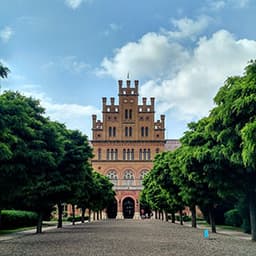STEM stands for Science, Technology, Engineering and Math. Young Logix courses address standards in all four categories.
The STEM acronym was first coined by the National Science Foundation in the early 1990s. The term STEM applied to any policy, event, curriculum, or education program dealing with Science, Technology, Engineering and Mathematics. The importance of integrating Science, Technology, Engineering and Mathematics is quickly becoming a priority in K-12 education and at colleges and universities in both undergraduate and graduate programs. STEM education is evolving into an integrative curriculum aimed at preparing students for the challenges of the 21stcentury. An integrative, applications-based STEM education program prepares our students to become creative and innovative problem solvers, researchers, engineers, and designers.
According to a 2008 report titled Pennsylvania STEM (Science, Technology, Engineering and Mathematics) Initiative and the Southwest PA STEM Network from The Education Policy and Leadership Center, in the 12 counties located in the Southwest Region, there are approximately 4,000 manufacturing businesses. The median number of employees is 50, and of those 50 employees, 12 are engineers/technicians. With the average age of the employees in the businesses being 50 or greater, approximately 24,000 engineers/technicians must be replaced along with 2,000 to 5,000 new jobs filled for Toshiba/Westinghouse in Cranberry and an unknown number of professionals/technicians in the medical sciences, Biotechnology, Energy, Clean Tech, Robotics, IT and not to mention the growing Marcellus Shale industry. The total number of STEM employees predicted to be needed during the next 10 to 15 years is approximately 35,000 to 50,000 in southwestern Pennsylvania alone.
Our first goal is to start our programs across the country throughout the schools and spread the STEM/STEAM education. Run robotics camps as they are a great way to spark student interest in the STEM/STEAM fields. Students have fun learning about robotics, computer programming, and don’t realize they are applying their science, technology, arts and math's knowledge to engineer solutions to a variety of robotic challenges. Introduce agile robotics to classes at the middle school and high school level may be in middle of 2017 school year.
Our second STEM/STEAM goal is to assess what we have in place now in terms of curriculum, technology, equipment and faculty expertise. Young Logix has an academic program and faculty second to none. Finding courses to integrate in order to develop STEM/STEAM pathways is our next order of business. We need to make sure we are using all of our current resources efficiently in developing a sustainable STEM/STEAM program that will distinguish Young Logix students from all other students in the county, state and nation.
Our third goal and a very important part of STEM/STEAM education, is to begin to establish internship and mentorship opportunities for students. We are looking at high school programs around the area to gain information to implement our own program. A committee of secondary guidance counselors and school administrators will be working on the development of a 12th grade internship class that pairs our students with local businesses to provide them authentic job experiences and mentorships.
The biggest challenge is to ensure we have a supply of well-educated workers who have the technical expertise necessary to fill the predicted 35,000 jobs that are going to be available during the next 10 or so years. The implication is that public education must step up to the plate and begin to develop partnerships with businesses, post-secondary education institutions, and government entities to work together to prepare our students to meet the needs of the future economy.
The most serious challenge our nation faces with regard to STEM/STEAM Education is the lack of diversity in STEM/STEAM fields. As a nation, it is imperative that all students have access to quality STEM/STEAM Education programs. Parents, teachers, counselors, and mentors need to especially to encourage girls and students of color throughout their K-12 level of education and continue to encourage them during their postsecondary studies to stick with and complete that degree in a STEM/STEAM field.
I wish I had a crystal ball and knew the answer to this question. We know that our students need to be prepared for jobs that are not yet on the radar. We need to prepare students to be able to compete in a knowledge-based economy. Students need 21stCentury skills of adaptability, complex communication, social skills, non-routine problem solving, self-management, self-development, and systems thinking. Our students will be required to be innovative and creative problem solvers, designers, developers, and inventors.
Here are some things you can do as a parent to encourage your child’s interest in Science, Technology, Engineering and Mathematics. This information is taken from National Aeronautics and Space Administration:
Parents can help their children by exhibiting attitudes and values that support learning. Encourage your child to ask questions and avoid negative statements like “I was never good at math”; be positive and expect your child to be successful.
- Help your child see how they encounter science, technology and mathematics in their everyday life. Whether it be in the sports section of the newspaper reviewing team statistics, cooking with your child or working around the house on painting or building projects, point out how mathematics, science or technology is being used.
- Encourage students to ask questions and explore careers early. How much education is required to be a mechanical engineer, a computer programmer, or a radiologist? What subjects should they be taking in school to prepare them for a STEM/STEAM career?
- Familiarize yourself with the national and state standards in science, arts, mathematics, and technology. Become aware of what your child should be learning at each grade level.
- Have your child involved in various organizations for volunteer work that help develop an interest in the STEM/STEAM fields.
- Take advantage of informal learning opportunities such as museums, science centers, planetariums, aquariums, zoos, and park/recreation programs. We live in an area that has excellent selection of informal learning opportunities and programs.
Ready to bring your digital vision to life?
Let's collaborate to create innovative solutions that stand out in the digital landscape. Reach out today and let's build something extraordinary together.


